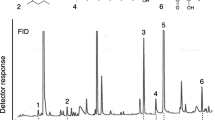Abstract
The monocyclic 14-membered ring diterpene, cembrene-A, previously identified as a nasutitermitine trail pheromone, was tested for its effectiveness as a trail pheromone inNasutitermes costalis. Artificial trails prepared from serial dilutions of racemic cembrene-A over a concentration range of 10−1–10−6 mg/ml were ineffective in recruiting termites. Serial dilutions of racemic cembrene-A ranging in concentration from 10−1 to 10−5 mg/ml produced an orientation effect. Chiral cembrene-A produced recruitment in soldiers at 10−1 and 10−3 mg/ml and was less ineffective in recruiting workers. Soldiers always showed a lower and more variable recruitment response to chiral cembrene-A than to sternal gland extracts. The behavioral response to both chiral and racemic cembrene-A was different in quantity and quality from that observed for sternal gland extract. Based on the results of these behavioral tests, cembrene-A appears to be a generalized nasute orientation pheromone which may show recruitment properties at unnaturally high concentrations.
Similar content being viewed by others
References
Birch, A.J., Brown, W.V., Corrie, J.E.T., andMoore, B.P. 1972. Neocembrene-A: A termite trail pheromone.J. Chem. Soc. Perkin. Trans. 1:2653–2658.
Hölldobler, B., andWilson, E.O. 1970. Recruitment trails in the harvester antPogonomyrmex badius.Psyche 77:385–399.
Howard, R., Matsumura, F., andCoppel, H.C. 1976, Trail-following pheromones of the Rhinotermitidae: Approaches to their authentication and specificity.J. Chem. Ecol. 2:147–166.
Hummel, H., andKarlson, P. 1968. Hexansaure als Bestandteil des Spurpheromons der TermiteZootermopsis nevadensis Hagen.Hoppe-Seyler's Z. Physiol. Chem. 349:725–727.
Kaib, M., Bruinsma, O., andLeuthold, R.H. 1982. Trail following in termites: Evidence for a multi-component system.J. Chem. Ecol. 8:1193–1205.
Kato, T., Suzuki, M., andKobayashi, T. 1980. Synthesis and pheromone activities of optically active neocembrenes and their geometrical isomers, (E, Z, E)- and (E, E, Z)-neocembrenes.J. Org. Chem. 45:1126–1130.
Leuthold, R.H., andLuscher, M. 1974. An unusual caste polymorphism of the sternal gland and its trail pheromone production in the termiteTrinervitermes bettonianus.Insectes Soc. 21:335–342.
Matsumura, F., Coppel, H.C., andTai, A. 1968. Isolation and identification of termite trail-following pheromone.Nature 219:963–964.
McDowell, P.G., andOloo, G.W. 1984. Isolation, identification and biological activity of the trail-following pheromone of the termiteTrinervitermes bettonianus.J. Chem. Ecol. 10:835–851.
Moore, B.P. 1966. Isolation of the scent-trail pheromone of an Austrailian termite.Nature 211:746–747.
Oloo, G.W., andMcDowell, P.G. 1982. Interspecific trail-following and evidence of similarity of trails ofTrinvervitermes species from different habitats.Insect. Sci. Appl. 3:157–161.
Prestwich, G.D. 1983. Chemical systematics of termite exocrine secretions.Annu. Rev. Ecol. Syst. 14:287–311.
Sokal, R.R., andRohlf, F.J. 1969.Biometry. W.H. Freeman, San Frncisco, California.
Stuart, A.M. 1969. Social behavior and communication, pp. 193–232,in K. Krishna and F.M. Weesner (eds.). Biology of Termites, Vol. 1, Academic Press, New York.
Stuart, A.M. 1981. The role of pheromone in the initiation of foraging, recruitment and defense by the soldiers of a tropical termite,Nasutitermes corniger Motschulsky.Chem. Senses 6:409–420.
Traniello, J.F.A. 1981. Enemy deterrence in the recruitment strategy of a termite: Soldier-organized foraging inNasutitermes costalis.Proc. Natl. Acad. Sci. U.S.A. 78:1976–1979.
Traniello, J.F.A. 1982a. Recruitment and orientation components in a termite trail pheromone.Naturwissenschaften 69:343–344.
Traniello, J.F.A. 1982b. The social organization of foraging in the Neotropical termiteNasutitermes costalis, pp. 42,in M.D. Breed, C.D. Michener, and H.E. Evans (eds.) The Biology of Social Insects. Westview Press, Boulder, Colorado.
Traniello, J.F.A., andBusher, C. 1985. Chemical regulation of polyethism during foraging the neotropical termiteNasutitermes costalis.J. Chem. Ecol. 11:319–332.
Tschinkel, W.R., andClose, P.G. 1973. The trail pheromone of the termiteTrinervitermes trinervoides.J. Insect Physiol. 19:707–721.
Author information
Authors and Affiliations
Rights and permissions
About this article
Cite this article
Hall, P., Traniello, J.F.A. Behavioral bioassays of termite trail pheromones. J Chem Ecol 11, 1503–1513 (1985). https://doi.org/10.1007/BF01012196
Received:
Accepted:
Issue Date:
DOI: https://doi.org/10.1007/BF01012196




